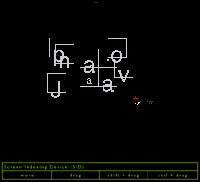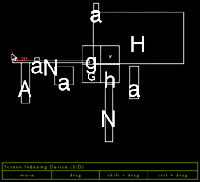
|
The work I have been doing at the Media Lab in the last year has been a
reflection on these issues. This work, for me, grew out of my research
as an art history doctoral student. I have titled my recent work
"Kinograffiti" to reflect a relation to both a history of moving images
and a desire to identify with a specific practice of cultural writing.
Graffiti interests me in that beyond being a form of writing, it is a
very public kind of writing. Its generous forms that suggest the
gestures of bodies in motion against architectural forms differ from,
say, diary entries, which could also be shown to operate publicly, but
along different tropological structures from those constituting street
graffiti. Graffiti is more cryptographic. It is also more emblematic.
Its forms are "tags," crossing the boundary from alphabetic territory
into a pictographic one. Graffiti seems paradoxical in the way that it
is both a gestural form, connoting an autograph, while it simultaneously
depends on reproduction for its life, also like an autograph or
signature. Individual tags exist in an economy of reproduction; they
bear a great deal of resemblance to other tags. Gestures composing one
tag may resemble those constituting a different tag. This gestural
economy accounts for a great deal of the recognizability of graffiti as
a form.
|
|



